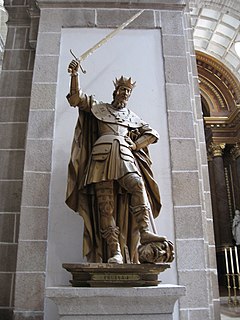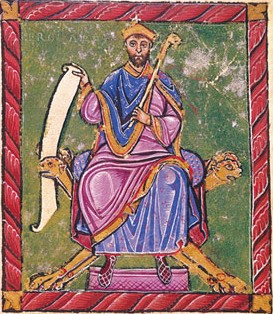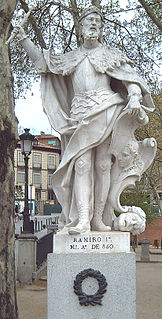 W
WAlfonso II of Asturias, nicknamed the Chaste, was the king of Asturias during two different periods: first in the year 783 and later from 791 until his death in 842. Upon his death, Nepociano, a family member of undetermined relation, attempted to usurp the crown in place of the future Ramiro I.
 W
WAlfonso III, called the Great, was the king of León, Galicia and Asturias from 866 until his death. He was the son and successor of Ordoño I. In later sources he is the earliest to be called "Emperor of Spain." He was also titled "Prince of all Galicia".
 W
WAlfonso Fróilaz, called the Hunchback, was briefly the king of the unified kingdom of Asturias, Galicia and León in 925. He succeeded his father, King Fruela II, in July 925 but was driven from the throne within the year by his cousins Sancho, Alfonso IV and Ramiro II, the sons of his uncle, Ordoño II. He was restored to a royal position in part of the kingdom after Alfonso IV took power in 926, but was violently deposed and forced into a monastery in 932.
 W
WBermudo I, called the Deacon or the Monk, was the King of Asturias from 788 or 789 until his abdication in 791. He was a son of Fruela of Cantabria, a nephew of Alfonso I, and a brother of Aurelius. The nature of the end of his reign ushered in a new period in Asturian-Arab relations.
 W
WFafila, Favila, or Favilac was the second King of Asturias from 737 until his death. He was the only son and successor of Pelagius, the first Asturian monarch, and was named after his paternal grandfather, who was the youngest son of Chindasuinth.
 W
WFruela I, called the Cruel, was the King of Asturias from 757 until his death, when he was assassinated. He was the eldest son of Alfonso I and continued the work of his father. Pelayo was his maternal grandfather.
 W
WFruela II was the King of Asturias from the death of his father, Alfonso III of Asturias, in 910 to his own death. When his father died, the kingdom was divided, with the third son, Fruela, taking the original portion (Asturias); the second, Ordoño, taking Galicia; and the eldest, García, taking León. As king of Asturias, he had the job of consolidating the region later called Castile and keeping its counts in check.
 W
WMauregatus the Usurper was the king of Asturias from 783 to 788 or 789. He was an illegitimate son of Alfonso I, supposedly by a Moorish serf. He usurped the throne on the death of Silo, his brother-in-law. The nobility had elected Alfonso II at Adosinda's insistence, but Mauregatus assembled a large army of supporters and forced Alfonso into Álava.
 W
WOrdoño I was King of Asturias from 850 until his death.
 W
WThe Pantheon of Asturian Kings is a chapel of Nuestra Señora del Rey Casto in the Cathedral of San Salvador, Oviedo, Spain. It is the burial place of many of the rulers of the medieval kingdoms of Asturias and León.
 W
WPelagius was an Iberian Visigoth nobleman who founded the Kingdom of Asturias in 718. Pelagius is credited with initiating the Reconquista, the Christian reconquest of the Iberian Peninsula from the Moors, and establishing the Asturian monarchy, making him the forefather of all the future Iberian monarchies, including the Kings of Castile, the Kings of León, and the Kings of Portugal.
 W
WRamiro I was King of Asturias from 842 until his death. He was son of King Bermudo I, and became king after a struggle for succession that followed the death of Alfonso II without issue. He was a contemporary of Abd ar-Rahman II, Umayyad Emir of Córdoba. During his turbulent reign, the chronicles relate that he had to fend off attacks from both Vikings and Moors. Numerous important structures, such as his recreational palace Santa María del Naranco, were built during his reign in the estilo ramirense that prefigured Romanesque architecture.
 W
WSilo was the king of Asturias from 774 to 783, succeeding Aurelius. He came to the throne upon his marriage to Adosinda, daughter of Alfonso I. He moved the capital of the Kingdom of Asturias from Cangas de Onís to Pravia, closer to the center of the kingdom. He was a contemporary of Abd al-Rahman I, Umayyad Emir of Córdoba, and of Charlemagne.